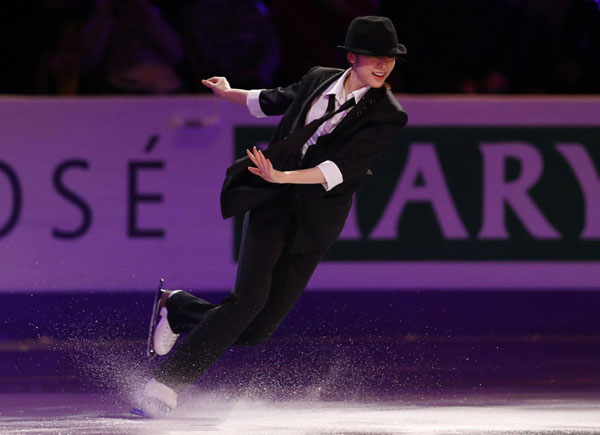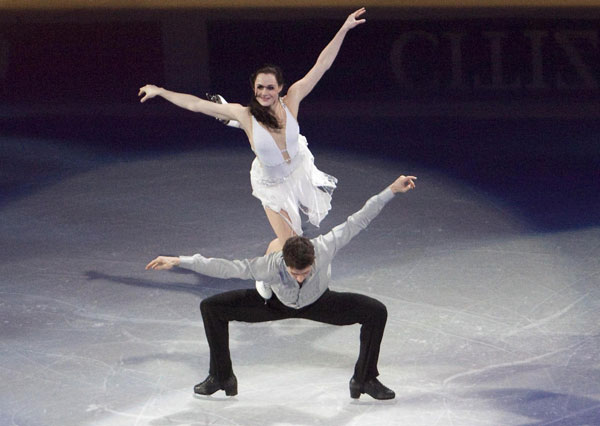Glitzy Gala cannot hide figure skating warts
Updated: 2013-03-18 11:12
(Agencies)
|
||||||||
It has been over a decade since the 2002 Salt Lake City Olympic judging scandal exposed the corrupt underbelly of figure skating, plunging the sport into a credibility crisis it is still trying to recover from.
Critics see the head-scratching results as more evidence that old biases remain firmly entrenched in the figure skating culture, where skaters are rewarded as much for their reputation as their performance.
 |
|
Yuna Kim of South Korea performs at the ISU World Figure Skating Championships gala presentation in London, Ontario March 17, 2013. [Photo/Agencies] |
"No question Salt Lake was a turning point," International Skating Union (ISU) vice-president David Dore told Reuters. "It seems no matter how hard we try I don't think we are ever going to escape that unfortunately.
"While we have made a fair system, it is a complicated system and I think we are still trying to explain it."
Skating officials admit that while the sport is flourishing in Asia, it is faltering in North America.
In a clear sign of down-sizing, this year's championship were awarded to London, a small southern Ontario city midway between Toronto and Detroit and held in a charming but smallish 7,000 seat junior hockey arena.
Not long ago, any major figure skating events held in North America were reserved for only the biggest of venues, the previous three worlds hosted in Canada (1996, 2001 and 2006) all staged in National Hockey League (NHL) rinks.
But those days are over and never coming back, according to Dore.
"I think everyone wants to come back to the big huge arenas and I don't think we are going back to that," he said. "Maybe we are in a smaller venue but reaching a broader audience then before with social media."
 |
|
Tessa Virtue and Scott Moir perform at the ISU World Figure Skating Championships gala presentation in London, Ontario, March 17, 2013. [Photo/Agencies] |
Officials insist there is more upside to holding an event in a packed smaller venue than a half full NHL arena but the fact the London worlds, featuring the comeback of Korean figure skating queen Kim Yu-na and the presence of hometown ice skating celebrities Olympic and world champion ice dancers Tessa Virtue and Scott Moir, could not fill the Budweiser Gardens every session shocked many.
The trend towards smaller venues has also hit the United States, which has taken the once hugely popular national championships to Omaha, Spokane and Greensboro, North Carolina in three of the last four years.
A red-hot television property at one time, live figure skating has all but disappeared from American living rooms.
"There was a boom in the '90s, there was an explosion of interest that created those packed 18,000 seat stadiums," David Raith, the executive director of US Figure Skating, told Reuters. "I think it can go back to that. We are looking to host the worlds in 2016 in a major city, in a major arena and we think we can fill it.
"Television ratings are not what they use to be.
"We want to see it edge back towards those astronomical numbers but I don't think anyone will ever see those numbers again in the United States.
"Things evolve. It use to be a horse and now it's a car."

 'Taken 2' grabs movie box office crown
'Taken 2' grabs movie box office crown
 Rihanna's 'Diamonds' tops UK pop chart
Rihanna's 'Diamonds' tops UK pop chart
 Fans get look at vintage Rolling Stones
Fans get look at vintage Rolling Stones
 Celebrities attend Power of Women event
Celebrities attend Power of Women event
 Ang Lee breaks 'every rule' to make unlikely new Life of Pi film
Ang Lee breaks 'every rule' to make unlikely new Life of Pi film
 Rihanna almost thrown out of nightclub
Rihanna almost thrown out of nightclub
 'Dark Knight' wins weekend box office
'Dark Knight' wins weekend box office
 'Total Recall' stars gather in Beverly Hills
'Total Recall' stars gather in Beverly Hills
Most Viewed
Editor's Picks

|

|

|

|

|

|
Today's Top News
Boston bombing suspect reported cornered on boat
7.0-magnitude quake hits Sichuan
Cross-talk artist helps to spread the word
'Green' awareness levels drop in Beijing
Palace Museum spruces up
First couple on Time's list of most influential
H7N9 flu transmission studied
Trading channels 'need to broaden'
US Weekly

|

|







